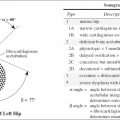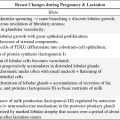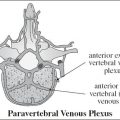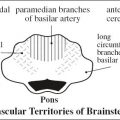Impending / Inevitable Abortion
= ABORTION IN PROGRESS
= gestational sac with embryo having become detached from implantation site → spontaneous abortion within next few hours
• Clinical triad: (1) bleeding > 7 days, (2) persistent painful uterine contractions, (3) rupture of membranes
• cervix moderately effaced / dilated > 3 cm
√ sac located low within uterus (DDx: cervical ectopic with closed internal os)
√ progressive migration of sac toward / into cervical canal (on rescanning a short time later)
√ dilated cervix
√ sac surrounded by anechoic zone of blood
Threatened Abortion
= 1st trimester bleeding (after period of implantation bleed at 3–4 weeks MA) with a live embryo
Frequency: 20–25% of all pregnancies
• Clinical triad: (1) mild bleeding, (2) cramping, (3) closed cervix
NONVIABILITY DIAGNOSIS WITH CERTAINTY
on transvaginal ultrasound
@ Cardiac activity:
√ no cardiac activity with a CRL ≥ 5 mm
√ no cardiac activity with certain GA ≥ 6.5 weeks
√ no cardiac activity with a GS diameter > 16 mm
@ Yolk sac:
√ no yolk sac with a GS diameter ≥ 20 mm
√ embryo visualized without demonstrable yolk sac
√ yolk sac diameter > 5.6 mm at < 10 weeks MA
@ GS contents:
√ fibrinous strands / residual embryonic debris (in 25%)
NONVIABILITY DIAGNOSIS WITH HIGH PROBABILITY
on transvaginal ultrasound
@ Ultrasound milestones not met as expected:
√ ≥ 5.0 weeks gestational sac first identifiable
√ ≥ 5.5 weeks yolk sac first identifiable
√ ≥ 6.0 weeks embryo and FHM first identifiable
@ Yolk sac:
√ no yolk sac with GS of 6–9 mm
√ distorted sac configuration
@ Choriodecidua
√ thinning of choriodecidual reaction with hypoechoic clefts
@ Cardiac activity:
√ no cardiac activity with GS of ≥ 9 mm
√ slow embryonic heart rate (=bradycardia):
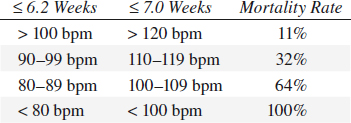
Predictors of poor outcome:
@ Bradycardia
√ < 85 bpm during 5–8 weeks EGA
@ Small sac size = “first-trimester oligohydramnios”
[misnomer: amnionic cavity is not diminished in size but rather the chorionic cavity]
= MSD (mean sac diameter) – CRL ≤ 5 mm (with a live embryo at 5.5–9.0 weeks)
Prognosis: miscarriage in 94%
@ Abnormal yolk sac
√ failure to visualize yolk sac at 5.5 weeks MA = mean diameter of GS ≥ 8 mm
√ yolk sac size > 5 mm
√ calcification / debris within yolk sac
√ double appearance of yolk sac
@ Abnormal amnion
√ mean diameter of amniotic cavity > CRL
@ Subchorionic hemorrhage
Frequency: in up to 18% of pregnancies during first half of pregnancy
N.B.: significance controversial
Prognosis: 50% develop normally; 15–39% blighted ovum, 4% mole, 4–13% ectopic pregnancy, 0–15% incomplete abortion, 17–57% missed abortion
Complete Abortion
• absence of transvaginal bleeding, cervix closed
• abrupt decline of serum β-hCG
√ IUP no longer visualized although documented previously
√ thin regular endometrium (< 10–15 mm) with apposed surfaces
√ absence of central / eccentric fluid-filled sac
DDx: nongravid state, very early IUP, ectopic pregnancy
Rx: dilatation & curettage may be avoided if IUP was documented previously
Incomplete Abortion
= RETAINED PRODUCTS OF CONCEPTION (RPOC)
= portion of chorionic villi (placental tissue) / trophoblastic tissue (fetal tissue) remaining within uterus after spontaneous abortion (= miscarriage) / planned termination / preterm or term delivery
= most frequent cause of secondary postpartum hemorrhage (2°PPH)
Incidence: › 1st trimester: 40%
› 2nd trimester 17%
› 3rd trimester: 3%
• incomplete placenta at delivery, patulous cervix
• continued (occasionally massive) genital bleeding (may occur months / years after last abortion / delivery)
• normal / low levels of β-hCG
US:
√ fetal parts / embryo / echogenic mass within uterine cavity (MOST ACCURATE SIGNS)
√ irregular / angulated small gestational sac containing amorphous echogenic material
√ ragged disrupted choriodecidual reaction
√ subchorionic fluid ± hemorrhage
√ intracavitary heterogeneously echogenic mass separate from endometrium
√ > 8–10–13 mm thickened endometrial echo complex
◊ Measurement of endometrial thickness alone is a poor test for diagnosing an incomplete miscarriage!
√ calcification of retained products (late finding)
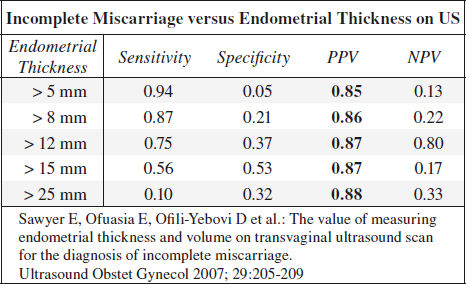
Doppler US (x 2 improvement in diagnosis):
√ ± increased vascularity in endometrial echo complex / intracavitary mass (compared to myometrium)
√ flow velocity > 21 cm/sec (supplying residual trophoblastic tissue)
√ ± low-resistance internal blood flow often at endometrial-myometrial interface
Pitfalls: uterine AVM (involves myometrium only), endometrial polyp, submucosal fibroid
MR:
√ partially / delayed enhancing heterogeneous mass on T1WI + T2WI (DDx: gestational trophoblastic disease)
Dx: presence of chorionic villi in curettage exhibiting variable vascularity
Cx: endometritis, myometritis, peritonitis, septic shock, diffuse intravascular coagulation (with retention > 1 month)
Rx: expectant management, uterotonic medication (prostaglandin E1 analogs), suction D&C after IV oxytocin, hysteroscopic removal
DDx: intraluminal blood clot, mole, blighted ovum, embryonic demise, intrauterine fetal death
PLACENTAL POLYP
= intrauterine polypoid mass formed by a retained fragment of placental tissue after an abortion / term pregnancy
Predilection: placenta accreta
MR:
√ hyperintense polypoid mass on T2WI
DDx: arteriovenous malformation, trophoblastic disease, endometrial polyp, submucosal myoma
SUBINVOLUTION OF PLACENTAL IMPLANTATION SITE
= exceptionally rare postpartum condition characterized by failure of uterine vessels to involute following delivery
Risk factors: atony, multiparity, cesarean section, uterine prolapse, uterine fibroids, endometritis, coagulopathy, RPOC
√ unusually large postpartum uterus
√ dilated myometrial vessels
Missed Abortion
= dead conceptus within uterine cavity for ≥ 8 weeks occurring prior to 28 weeks MA
Time of diagnosis: not before 13 weeks MA
• brownish vaginal discharge, closed firm cervix
√ no cardiac activity in a well-defined embryo with CRL > 9 mm (on abdominal scan) / CRL > 5 mm (on TV scan)
√ gestation not in correspondence with menstrual age
√ sac > 25 mm in diameter without an embryo
(DDx: anembryonic pregnancy)
√ sac > 20 mm without yolk sac
√ crenated irregular / distorted angular sac configuration
√ stringlike debris within gestational sac (in 25%)
√ discontinuous / irregular / thin (2 mm) choriodecidual reaction
√ no double decidual sac
√ low sac position
√ subchorionic collection
Cx: coagulopathy ← low plasma fibrinogen (after 4 weeks in 2nd trimester pregnancy)
Rx: suction D&C (in 1st trimester); prostaglandin E suppositories (in 2nd trimester)
DDx: blighted ovum
ACARDIA
= ACARDIAC MONSTER = TWIN REVERSED ARTERIAL PERFUSION SEQUENCE (TRAP)
= rare developmental anomaly of monochorionic twinning in which one twin develops without a functioning heart
Prevalence: 1÷30,000–35,000 births; in 1% of monozygotic twins
Pathophysiology:
normal twin perfuses acardiac twin through artery-to-artery + vein-to-vein anastomoses in shared placenta → reversed circulation alters hemodynamic forces → abnormal cardiac morphogenesis
Spectrum:
(1) Holoacardia = no heart at all
(2) Pseudoacardia = rudimentary cardiac tissue
√ proximity of the 2 cord insertions on placental surface linked by an arterioarterial anastomosis
√ reversed arterial flow in cord toward acardiac twin
√ fused placentas
√ polyhydramnios
A. PUMP TWIN
Risk: increased for fetal demise + preterm labor
√ morphologically normal
√ cardiac overload signs: hydrops, IUGR, hypertrophy of right ventricle, increased cardiothoracic ratio, hepatosplenomegaly, ascites
B. PERFUSED TWIN = ACARDIAC TWIN
Pathophysiology: vascular anastomosis sustains life of acardiac monster
Associated with: monochorial placenta (= same gender); wide range of abnormalities
√ absent / rudimentary heart (“acardius”)
√ tiny / absent cranium (acephalus)
√ small upper torso ± absent / deformed upper extremities
√ marked integumentary edema + cystic hygroma
Prognosis: mortality of 100% for perfused twin, 50% for pump twin (increased with increased size of acardiac twin)
Rx: laser ablation of umbilical cord to acardiac twin (up to 20–22 weeks)
ADENOMYOSIS
= ENDOMETRIOSIS INTERNA (term no longer used)
= focal / diffuse benign invasion of myometrium by endometrium (heterotopic “endometrial islands”) inciting reactive myometrial (smooth muscle) hyperplasia
Cause: ? uterine trauma (parturition, myomectomy, curettage), chronic endometritis, hyperestrogenemia
Prevalence: 5–70% of hysterectomy specimens
Hormonal dependency:
ectopic endometrial glands of adenomyosis (= generally of basalis type of endometrium) do NOT respond to cyclic ovarian hormones (largely nonfunctioning ← resistance to hormonal stimulation unlike endometriosis); some degree of proliferative + secretory changes occur during menstrual cycle; tamoxifen (= nonsteroidal antiestrogen) increases incidence of adenomyosis in postmenopausal women
Path: endometrial glands deeper than ¼ of thickness of junctional zone = 2–3 mm below endometrial-myometrial junction
Histo: endometrial glands + stroma within myometrium surrounded by smooth muscle hyperplasia
Age: multiparous premenopausal women > 30 years during menstrual life (later reproductive years)
Associated with: endometriosis (in 36–40%)
Types: diffuse form / focal (localized circumscribed) form
• asymptomatic in 5–70%; pelvic pain, menorrhagia, dysmenorrhea (abates after menopause)
√ globular uterine enlargement
HSG:
√ multiple small linear / saccular diverticula extending into myometrium
√ uterine cavity may be enlarged / distorted
√ irregular masslike filling defect in uterine fundus in focal adenomyosis
US (53–89% sensitive, 67–98% specific, 68–86% accurate):
√ poorly marginated hypoechoic heterogeneous areas within myometrium + myometrial cysts
√ globular / asymmetrically enlarged uterus
MR (78–93% sensitive, 66–93% specific, 85–90% accurate):
√ diffuse / focal thickening of junctional zone forming an ill-defined area of low SI ± embedded bright foci on T2WI
Cx: infertility
Rx: conservative medical treatment (analgesics + minimally effective menstrual suppression Rx with danazol / GnRH agonist); surgical treatment (endometrial ablation, laparoscopy, lesion excision; alternatively uterine artery embolization; hysterectomy (the only definitive cure for debilitating adenomyosis)
Cystic Adenomyosis
= very rare well-circumscribed cystic myometrial lesion of hemorrhage in different stages of organization (in 40% of diffuse adenomyosis, in 100% of focal adenomyosis)
Path: extensive menstrual bleeding into ectopic endometrium ← unusual response to cyclical ovarian hormones
Location: uterine origin confirmed by (a) myometrial splaying around lesion, (b) “bridging vessel” sign (c) separate distinct identification of ovaries
√ “Swiss cheese” appearance of myometrium on US
√ miniature uterus:
√ fluid content of high SI ← hemorrhage at different stages of organization similar to endometriotic cyst
√ surrounding wall of inner zone of low SI on T1WI (= junctional zone)
√ relatively bright outer myometrium
| DDx: | (1) Leiomyoma with hemorrhagic degeneration |
(2) Hematometra |
Diffuse Adenomyosis (67%)
In 90% associated with: pelvic endometriosis (in women < 36 years of age)
• infertility ← impaired uterine contractility for directed sperm transport
US:
√ smooth uterine enlargement (DDx: diffuse leiomyomatosis)
√ asymmetric thickening of anterior and posterior myometrial walls
√ diffuse heterogeneous myometrial echotexture (in 75%):
√ nodular / linear areas of increased myometrial echogenicity (= heterotopic endometrial tissue)
√ area of decreased myometrial echogenicity (= smooth muscle hyperplasia)
√ HIGHLY SPECIFIC < 5 mm small subendometrial cysts (in 50%) ← dilated cystic glands / hemorrhagic foci
√ widening of junctional zone > 12 mm on T2WI
√ poor definition of endomyometrial junctional zone (= endometrial tissue extending into myometrium)
√ pseudowidening of endometrium ← increased myometrial echogenicity
√ lack of uterine contour abnormality / mass effect
MR:
√ enlargement of the uterus
√ widening of junctional zone (= inner myometrium) ≥ 12 mm hypointense on T2WI, T2-weighted SE images, contrast-enhanced T1WI ← hyperplasia of smooth muscle
√ bright foci on T2WI (50%) ← islands of ectopic endometrial tissue + cystic dilatation of glands:
√ pseudowidening of endometrium (= indistinct foci of endometrial invasion of myometrium)
√ myometrial cysts + nodules, linear striations
√ foci of high SI on T1WI ← hemorrhage within ectopic endometrial tissue
√ variable degrees of enhancement always less than adjacent myometrium
| DDx: | (1) Marked physiologic thickening of junctional zone during menstruation (esp. cycle days 1 + 2) |
(2) Myometrial contraction (ill-defined hypointense area on T2WI in up to 75%, transient nature, distortion of endometrial lining) | |
(3) Muscular hypertrophy (hypoechoic inner myometrium, diffuse junctional zone thickening) | |
(4) Endometrial carcinoma (error in staging if adenomyosis coexists) |
Focal Adenomyosis (33%)
= “ADENOMYOMA”
√ polypoid mass (= polypoid adenomyoma / adenomyomatous polyp) protruding into uterine cavity (less commonly in myometrial / subserosal location)
US:
√ focal echogenic myometrial mass of 2–7 cm in diameter:
√ mass of oval / elongated shape with ill-defined margins
√ contiguity with junctional zone
√ penetrating vascular pattern
√ oval myometrial mass with indistinct margins of primarily low SI on all sequences ← surrounding reactive dense smooth muscle hypertrophy
√ widening of the junctional zone from 8 mm up to 12 mm
√ focal thickening of junctional zone > 12 mm
√ linear / round foci of high SI on T1WI within mass ← T1 shortening effect of methemoglobin in hemorrhagic foci
√ spotty signal voids on GRE ← T2*-shortening effect of hemosiderin in old hemorrhagic foci
√ foci of central high-intensity spots / linear striations on T2WI (= dilated endometrial glands in secretory phase / endometrial cyst, hemorrhagic focus) in 50%
√ low to intermediate SI on DWI ← benign neoplastic nature
Rx: polypectomy / myomectomy
DDx:
(1) Fibroid = leiomyoma (round hypoechoic mass anywhere in myometrium, well-defined margins, separate from junctional zone, calcifications, edge shadowing, whorled appearance, draping pattern of dilated vessels in periphery of mass, low SI on T1WI + T2WI, no small foci of high SI on T2WI)
(2) Adenomatoid tumor of uterus
= rare benign mesothelial tumor difficult to distinguish from leiomyoma / adenomyoma
(3) Metastatic myometrial involvement by cancer of breast, stomach, malignant lymphoma
(4) Low-grade endometrial stromal sarcoma (rare, young woman, extensive myometrial invasion)
AMNIOTIC BAND SYNDROME
= CONGENITAL CONSTRICTION BAND SEQUENCE = EARLY AMNION RUPTURE SYNDROME
= “slash defects” in nonanatomic distribution
Pathogenesis:
(a) early amniotic rupture exposing the fetus to the injurious environment of constrictive fibrous mesodermic bands that emanate from the chorionic side of the amnion
(b) vascular disruption events
Prevalence: 0.5–1.0÷10,000 live births
√ very thin sheet / band attached to fetus:
√ fine linear echoes that extend from fetal defect to uterine wall but are difficult to see
√ membrane that flaps with fetal movement
√ restriction of fetal motion ← entrapment of fetal parts by bands
Associated with fetal deformities in 77%:
1. Limb defects (multiple + characteristically asymmetric)
√ simple grooves / constriction rings of limbs / digits
√ amputation of limbs / digits
√ distal syndactyly
√ clubbed feet (30%)
√ gibbus deformity of spine
2. Craniofacial defects
= asymmetric nonanatomic defects of skull + brain
√ pterygium, facial cleft
√ anencephaly
√ asymmetric lateral encephalocele
√ facial clefting of lip / palate
√ asymmetric microphthalmia
√ incomplete / absent cranial calcification
√ ± attachment of head to uterine wall
3. Visceral defects
√ thoracoschisis
√ abdominoschisis ± exteriorization of liver
√ normal umbilical cord
DDx of abdominoschisis due to bands from body stalk anomaly depends on demonstration of a normal umbilical cord.
√ abdominal contents floating in amniotic fluid without clear visualization of encasing membrane
| DDx: | (1) Chorioamnionic separation ← subchorionic hemorrhage |
(2) Intrauterine synechiae | |
(3) Adams-Oliver syndrome (aplasia cutis, limb defects), scalp and skull defects at vertex associated with often asymmetric transverse limb defects | |
(4) Body stalk anomaly |
ANEMBRYONIC PREGNANCY
= BLIGHTED OVUM
= abnormal intrauterine pregnancy with developmental arrest prior to formation of embryo; may occur as a blighted twin
Cause: early arrest of embryonic development related to chromosomal abnormality
• ± vaginal bleeding
√ empty gestational sac (> 6.5 weeks MA)
√ yolk sac identified without embryo:
√ vanishing (passed) yolk sac on serial scans
√ gestational sac small / appropriate / large for dates:
√ decrease in gestational sac (GS) size
√ GS fails to grow by > 0.6 mm/day on serial scans
√ irregular weakly echogenic decidual reaction of < 2 mm
√ distorted sac shape
(a) by transabdominal scan:
GS usually not visualized before 5.0–5.5 weeks MA; yolk sac forms at 4 weeks MA when GS is 3 mm; embryo usually visualized by 6 weeks MA
√ GS size ≥ 10 mm of mean diameter without DDS
√ GS size ≥ 20 mm of mean diameter without yolk sac
√ GS size ≥ 25 mm of mean diameter without embryo
(b) by transvaginal scan
normal intradecidual GS routinely detected at 4–5 weeks with a mean sac diameter of 5 mm
√ GS size ≥ 8 mm of mean diameter without yolk sac
√ GS size ≥ 16 mm of mean diameter without cardiac activity
Cx: first trimester bleeding
ARTERIOVENOUS MALFORMATION OF UTERUS
= UTERINE ARTERIOVENOUS FISTULA = UTERINE CIRSOID ANEURYSM
Associated with: dilatation & curettage, endometrial carcinoma, gestational trophoblastic disease
• genital bleeding, often requiring blood transfusions
MR:
√ tortuous tubular signal voids in myometrium / parametrium / protruding into endometrial cavity on T1WI + T2WI
√ vascular lake with sluggish flow hyperintense on T2WI
√ intensely enhancing lesion isointense to vessels on contrast-enhanced dynamic subtraction MR
ASHERMAN SYNDROME
= association of multiple intrauterine synechiae (= adhesions consisting of fibrous tissue or smooth muscle) with menstrual dysfunction + infertility
Cause: sequelae of endometrial trauma (vigorous instrumentation during dilatation & curettage) usually during postpartum or postabortion period / severe endometritis
Path: scars / bands of fibrous tissue (synechiae) connect opposing sides of the endometrium by crossing the endometrial cavity; scars cause the endometrial cavity to contract resulting in an irregular surface
• hypomenorrhea / amenorrhea; habitual abortion / sterility
HSG:
√ solitary / multiple filling defects
√ bands of tissue traversing endometrial cavity
√ irregular surface contour of uterine cavity
√ small uterine cavity partially / near completely obliterated (DDx: DES exposure)
Sonohysterography:
√ echogenic bands bridging the uterine cavity
◊ Thick fibrotic bands may prevent complete uterine distension
MR:
√ small thin irregular endometrial cavity
BARTHOLIN GLAND CYST
= retention cyst
Origin: derived from urogenital sinus, female homologue of male (bulbourethral) Cowper glands
Cause: chronic inflammation / infection of gland → ductal obstruction from purulent material / thick mucus
Histo: lined by mucinous transitional cell / columnar epithelium
Location: posterolateral inferior ⅓ of vaginal introitus medial to labia minora at / below level of pubic symphysis
Size: 1–4 cm
√ unilocular cyst hyperintense on T2WI
√ variable T1 hyperintensity depending on proteinaceous / mucinous contents
Rx: administration of silver nitrate; marsupialization; surgical excision
BECKWITH-WIEDEMANN SYNDROME
= EMG SYNDROME (Exomphalos = omphalocele, Macroglossia, Gigantism)
= common autosomal dominant overgrowth syndrome with reduced penetrance + variable expressivity related to short arm of chromosome 11; sporadic in 85%
Prevalence: 1÷13,700 to 1÷14,300 live births; M÷F = 1÷1
4% risk for developing embryonal tumors:
nephro-, hepato-, pancreatoblastoma, rhabdomyosarcoma
• neonatal polycythemia
√ advanced bone age
Constellation:
(1) Hemihypertrophy 13–33%
(2) Hyperplastic visceromegaly: 57%
kidney, liver (hepatomegaly), spleen, pancreas, clitoris, penis, ovaries, uterus, bladder
(3) Abdominal wall defects
(a) Omphalocele 76%
(b) Umbilical hernia 49%
(c) Diastasis recti 33%
(4) Macroglossia 98%
(5) Facial nevus flammeus 63%
(6) Ear lobe creases and pits 66%
(7) Prominent eyes with intraorbital creases
(8) Infraorbital hypoplasia 81%
(9) Gastrointestinal malrotation 83%
(10) Pancreatic islet hyperplasia → hyperglycemia
(11) Cardiac anomalies
(12) Natal / postnatal gigantism 77%
@ Adrenal gland
Histo: adrenocortical hyperplasia, hyperplastic adrenal medulla, cystic adrenal cortex, bilateral adrenal cytomegaly (= enlargement of fetal cortical cells)
@ Kidney
Histo: disordered lobar arrangement, medullary dysplasia
√ nephromegaly
√ increased cortical echogenicity ← glomeruloneogenesis
√ accentuation of corticomedullary definition
√ medullary sponge kidney
√ pyelocalyceal diverticula
OB-US:
√ LGA fetus with growth along 95th percentile
√ polyhydramnios (51%)
√ thickened placenta
√ long umbilical cord
| Cx: | (1) Development of malignant tumors (in 4%) |
(2) Neonatal hypoglycemia (50–61%) |
BRENNER TUMOR
= almost always benign uncommon epithelial-stromal ovarian tumor
Frequency: 1.5–2.5%
Histo: transitional epithelial cells (similar to urothelium) within prominent fibrous connective tissue stroma
Associated with: mucinous cystadenoma / other epithelial tumor in 20–30%
Peak age: 40–70 years
• may have estrogenic activity
Size: most 1–2 cm (up to 30 cm) in diameter; bilateral in 5–7%
√ ± extensive calcifications
US:
√ usually hypoechoic solid homogeneous tumor with well-defined back wall
MR:
√ markedly hypointense tumor component on T2WI (fibrous component + calcifications)
√ moderate enhancement (DDx: hypovascular fibrothecoma)
CERVICAL CARCINOMA
◊ Most common gynecologic malignancy in developing countries; 3rd most common gynecologic malignancy (after endometrial + ovarian cancer) in USA; 6th most common cause of death from cancer in women
Highest prevalence: Central + South America > South Central Asia > parts of Africa
Incidence: 12÷100,000 women annually; 12,990 new cases + 4,120 deaths in USA (2016)
Peak age: 45–55 years
Histo: squamous cell carcinoma (80–95%) arising low in endocervical canal, adenocarcinoma (5–20%) arising from endocervical columnar epithelium, clear cell adeno-carcinoma (unusual) in women exposed to DES in utero
Risk factors: lower socioeconomic standing, Black race, early marriage, multiparity, early age at first intercourse, multiple sexual partners, cigarette smoking, immuno- suppressed state, use of oral contraceptives, human papilloma virus infection (HPV serotypes 16, 18, 31, 33, 56 → > 80% of all invasive cervical carcinomas)
Significance of tumor size:
> 4 cm: nodal metastases (80%), local recurrence (40%), distant metastases (28%)
< 4 cm: nodal metastases (16%), local recurrence (5%), distant metastases (0%)
(a) direct extension to lower uterine segment + vagina + paracervical space along uterosacral and broad ligaments
(b) lymphatic: paracervical > parametrial > hypogastric + obturator > external iliac > common iliac + presacral > para-aortic nodes
(c) hematogenous: lung, liver, bone
• leukorrhea ± abnormal vaginal bleeding (< 30%)
• intermenstrual / postcoital bleeding / metrorrhagia
Clinical staging: limited accuracy of 66% stage I (78%), stage III (25%)
Location:
arises almost exclusively from transformation zone (= squamo- columnar junction)
(a) on cervix (in young woman)
(b) in endocervical canal (older woman)
with protrusion into vagina / invasion of lower myometrium
Tumors tend to be exophytic in younger patients + endophytic in older patients ← variable location of transformation zone with advancing age
US:
@ Primary tumor
√ small tumor isoechoic to mucosa difficult to detect
√ altered echotexture + distortion of normal cervical morphology + lack of compressibility with increasing size
√ color Doppler US may facilitate visualization and delineation of tumor ← hypervascular tumor (in 95%)
CT:
@ Primary tumor
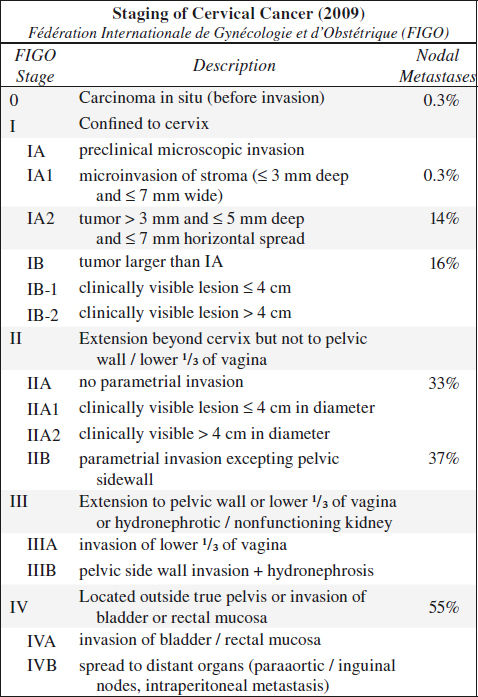
√ growth pattern: exophytic, infiltrating, endocervical
√ bulky enlargement of cervix > 3.5 cm (DDx: cervical fibroid)
√ iso- (50%) / hypoattenuating after IV contrast ← necrosis, ulceration, reduced vascularity
√ gas within tumor (necrosis / prior biopsy)
√ fluid-filled uterus (blood, serous fluid, pus) ← obstruction
√ hypoattenuating lesion of myometrium / with vaginal distension
@ Parametrial spread (30–58% accuracy):
√ parametrial soft-tissue mass
√ ureteral encasement
√ thickening of ureterosacral ligaments
√ > 4-mm soft-tissue strands of increased attenuation extending from cervix into parametria, cardinal / sacrouterine ligaments
√ obliteration of fat planes
√ ill-defined irregular cervical margins
√ eccentric parametrial enlargement
DDx: parametrial inflammation ← instrumentation, ulceration, infection, prior pelvic surgery, endometriosis
@ Pelvic side wall disease
√ tumor < 3 mm from side wall
√ enlarged piriform / obturator internus muscles
√ encasement of iliac vessels
√ destruction of pelvic bones
@ Pelvic visceral disease (60% PPV)
√ loss of perivesical / perirectal fat plane
√ asymmetric nodular thickening of bladder / rectal wall
√ intraluminal mass
√ air in bladder ← fistula
@ Lymphatic spread (65–77–80% accuracy)
√ nodes > 1 cm in diameter (> 7 mm for internal iliac nodes, > 9 mm for common iliac nodes, > 10 mm for external iliac nodes) with 44% sensitivity
√ lymph node necrosis (100% PPV)
DDx: adenopathy from secondary tumor infection
MR (76–78–91% accuracy for staging, 82–94% accuracy for parametrial involvement):
@ Primary tumor
√ focal bulge / mass in cervix:
√ mass isointense on T1WI
√ hyperintense on T2WI compared with fibrous stroma (DDx: postbiopsy changes, inflammation, nabothian cysts)
√ size of tumor accurately depicted (on T2WI rarely overestimated due to inflammation / edema)
◊ Tumor diameter and probability of recurrence + metastases are related; tumor diameter > 4 cm (stage IB2) means no surgical treatment
√ early contrast enhancement on fat-saturated T1WI
√ blurring + widening of junctional zone (retained secretions in uterine cavity) ← obstruction of cervical os
√ disruption of hypointense vaginal wall by hyperintense thickening on T2WI
√ disruption of hypointense cervical fibrous stromal ring on T2WI by nodular / irregular tumor SI
@ Parametrial invasion (best seen on T1WI):
√ low-intensity spiculated areas of soft tissue radiating from periphery of cervical mass
√ irregular lateral margins of cervix = linear stranding around cervical mass
√ thickening of uterosacral ligament
@ Pelvic sidewall invasion
√ tumor involves obturator internus, piriform, levator ani m.
√ dilatation of ureter + hydronephrosis
@ Pelvic visceral disease
√ disruption of hypointense walls of bladder / rectum (DDx: hyperintense thickening of bladder wall on T2WI ← bullous edema)
@ Lymphatic spread
√ lymphadenopathy > 10 mm, hyperintense compared with muscle / blood vessels on T2WI
PET/CT:
Indication: staging, restaging, evaluation of response to therapy
Pitfalls:
(1) Cyclical endometrial uptake during ovulatory + menstrual phases
(2) Attenuation correction artifact with metallic prosthetic implants, IUD, surgical clips
(3) Physiologic ovarian uptake in premenopausal women by corpus luteum
(4) Uptake by uterine leiomyoma
(5) Uptake by postsurgical healing, radiation fibrosis, infection
Prognosis: depending on tumor stage + volume of primary mass + histologic grade + lymph node metastases; in 30% recurrent / persistent disease (usually within 2 years)
| 5-year survival rate: | tumor diameter ≤ 1 cm 84% |
| tumor diameter > 4 cm 67% | |
| stage IIB 65% | |
| stage III 40% | |
| stage IVA < 20% |
Cx: stenosis + obstruction of cervical canal → hydrometra, hematometra, pyometra
| Rx: | (1) Surgery for stages < IIA / tumor < 4 cm |
(2) Radiation therapy ± chemotherapy for stages > IIB |
Prevention: human papillomavirus vaccine
| DDx: | (1) Endometrial polyp / adenocarcinoma (centered in endometrial cavity protruding into endocervical canal) |
(2) Prolapsed submucosal fibroid (more hypointense on T2WI) |
Recurrent Cervical Carcinoma
= local tumor growth / development of distant metastasis ≥ 6 months after complete regression
@ Pelvic recurrence
Prevalence: varies with stage, histologic type, adequacy of therapy, host response; 11% in stage IB
Site: cervix, uterus, vagina / vaginal cuff, parametria, ovaries, bladder, ureters, rectum, anterior abdominal wall, pelvic side wall
• lower extremity swelling ← lymphatic obstruction
• pain ← nerve compression, ureteral obstruction
√ hydrometra ← obstruction by preserved cervix
√ rectovaginal fistula
√ hydronephrosis (70% by autopsy)
√ vesicovaginal fistula
√ pelvic side wall mass
DDx: radiation fibrosis (82% MR accuracy)
@ Nodal recurrence
◊ Prognosis worsens as nodal involvement progresses!
(a) primary: paracervical, parametrial, internal + external iliac, obturator nodes (= medial group of the external iliac nodes)
Frequency: in 75% of adenocarcinoma, in 61% of squamous cell carcinoma (autopsy)
(b) secondary: sacral, common iliac, inguinal, paraaortic nodes
Frequency: in 62% of adenocarcinoma, in 30% of squamous cell carcinoma (autopsy)
@ Solid abdominal organ recurrence
Location: liver (33%) > adrenal gland (15%) > spleen, pancreas, kidney
@ Peritoneal recurrence
1. Peritoneal carcinomatosis (5–27% by autopsy)
2. Tumor deposits in mesentery + omentum
• Sister Joseph nodule = umbilical metastasis developing from anterior peritoneal surface
@ GI tract recurrence
Location: rectosigmoid junction (17%), colon, small bowel
√ fistula formation
√ focal bowel wall thickening + tethering
√ intestinal obstruction (12% by autopsy)
Prognosis: immediate cause of death in 7%
@ Chest recurrence
1. Lung metastases (33–38% by autopsy)
2. Pleural metastases associated with hydrothorax
3. Pericardial metastasis
4. Lymphangitic carcinomatosis (< 5%)
5. Mediastinal / hilar adenopathy + pleural lesions / effusion
@ Osseous recurrence
Prevalence: 15–29% by autopsy
Location: vertebra > pelvis > rib > extremity
Mechanism: direct extension from paraaortic nodes (most common) / lymphatic / hematogenous spread
@ Skin + subcutaneous tissue recurrence (in up to 10%)
CHORIOAMNIONIC SEPARATION
(a) normally seen < 16 weeks MA
Cause: incomplete fusion of amniotic membrane with chorionic plate
(b) abnormal > 17 weeks MA
Cause: hemorrhage / amniocentesis (10%)
√ membrane extends over fetal surface + stops at origin of umbilical cord
√ elevated membrane thinner than chorionic membrane
Cx: rupture of amniotic membrane → may lead to amniotic band syndrome
DDx: amniotic band syndrome, uterine synechia, fibrin strand after amniocentesis, cystic hygroma (moves with embryo)
CHORIOANGIOMA
= benign vascular malformation of proliferating capillaries (= hamartoma) without malignant potential
Prevalence: 0.5–1.0% of pregnancies; > 5 cm in 1÷3,500 to 1÷16,000 births
◊ Most common tumor of the placenta
Histo: angiomatous (capillary), cellular, degenerative subtypes
Location: usually near the umbilical cord insertion site supplied by fetal circulation
• elevated maternal serum α-fetoprotein level (rare)
US:
√ well-circumscribed hypo- / hyperechoic rounded intraplacental mass protruding from the fetal surface of the placenta into amniotic cavity
√ contains anechoic cystic areas (= vessels)
√ arterial signal on Doppler ultrasound in angiomatous chorioangioma
MR:
√ placental mass with high T2 SI (similar to hemangioma)
√ heterogeneous SI ← acute infarction + degenerative changes
Prognosis: regression after infarction
Maternal Cx: preterm labor, toxemia, placental abruption, preeclampsia, hemorrhage
polyhydramnios (in ⅓), fetal hydrops, fetal hemolytic anemia, fetal thrombocytopenia, cardiomegaly, IUGR, congenital anomalies, fetal demise (with large / multiple lesion)
Rx: expectant management with serial US imaging (6–8 week intervals for small tumors, 1–2 week intervals for large tumors); serial fetal transfusion, fetoscopic laser coagulation, chemosclerosis with absolute alcohol, endoscopic surgical devascularization
DDx: partial hydatidiform mole, placental hematoma, teratoma, metastasis, leiomyoma
CHORIOCARCINOMA
= remarkably aggressive
Frequency: < 1%
Primary Ovarian Choriocarcinoma
= NONGESTATIONAL CHORIOCARCINOMA
Prevalence: extremely rare; 50 cases in world literature
Age: < 20 years
Associated with: germ cell tumor / epithelial neoplasm
• ↑ serum hCG (100% sensitive, 100% specific)
• isosexual precocity (50%)
√ usually unilateral
√ vascular predominantly solid tumor with areas of hemorrhage + necrosis + cyst formation
Prognosis: 90% 5-year survival in spite of typically late diagnosis at advanced stage
DDx: ectopic pregnancy (frequently mistaken diagnosis!), metastasis to ovary from gestational choriocarcinoma (reproductive age)
Gestational Ovarian Choriocarcinoma
Cause: metastasis from uterine choriocarcinoma (frequently bilateral ovarian masses); arising from ectopic ovarian pregnancy (extremely rare)
Age: reproductive age
Gestational Uterine Choriocarcinoma
Prevalence: 5% of gestational trophoblastic diseases
Age: child-bearing age
Histo: biphasic pattern including syncytiotrophoblastic + cytotrophoblastic proliferation without villous structures; extensive necrosis + hemorrhage; early + extensive vascular invasion
Preceded by: mnemonic: MEAN
Mole (hydatidiform) in 50.0%
Ectopic pregnancy in 2.5%
Abortion, spontaneous in 25.0%
Normal pregnancy in 22.5%
• continued elevation of hCG after expulsion of molar / normal pregnancy (25%); continued vaginal bleeding
US:
√ mass enlarging the uterus
√ mixed hyperechoic pattern (hemorrhage, necrosis)
CT (useful for staging):
√ heterogeneous predominantly hypoattenuating intrauterine tissue
√ detection of distant metastases
MR:
√ heterogeneous hyperintense mass on T2WI
√ focal signal voids (= vessels) on T1WI + T2WI
√ disruption of hypointense myometrium (= local invasion)
√ marked enhancement ← high vascularity
√ enhancing parametrial tissue (= local spread)
Metastases:
(a) hematogenous (usually): lung, kidney (10–50%), brain
√ radiodense pulmonary masses with hazy borders ← hemorrhage + necrosis
√ hyperechoic hepatic foci
(b) lymphatic: pelvic lymph nodes
(c) direct extension (occasionally): vagina
Prognosis: 85% cure rate (even with metastases); fatal with spread to kidneys + brain
| Rx: | (1) Chemotherapy: methotrexate, actinomycin D ± cyclophosphamide |
(2) Hysterectomy (if at risk for uterine rupture) |
DDx: mnemonic: THE CLIP
True mole
Hydropic degeneration of placenta
Endometrial proliferation
Coexistent mole and fetus
Leiomyoma (degenerated)
Incomplete abortion
Products of conception (retained)
CLEAR CELL NEOPLASM OF OVARY
= MESONEPHROID TUMOR
= almost always invasive carcinoma
Frequency: 2–5–10% of all ovarian cancers
Histo: clear cells (cuboidal cells with clear cytoplasm) + hobnail cells (columnar cells with large nuclei projecting into the lumina of glandular elements); identical to clear cell carcinoma of endometrium, cervix, vagina, kidney; ~ 100% malignant
Not associated with: in utero DES exposure (like lesions of the vagina + cervix)
• 75% of patients present with stage I disease
√ frequently unilocular cyst + mural nodule(s)
Prognosis: 50% 5-year survival rate (better than for other ovarian cancers)
CLOACAL EXSTROPHY
= exstrophy of all structures forming cloaca (rectum, bladder, lower GU tract) similar to bladder exstrophy
Prevalence: 1÷200,000–400,000 live births; M < F
Cause: ? premature rupture of cloacal membrane; ? abnormal overdevelopment of lower cloaca preventing mesenchymal tissue migration: ? abnormal fusion of genital tubercle below cloacal membrane; ? abnormal caudal position of body stalk; ? failure of mesenchymal ingrowth
Associated abnormalities: OEIS
(a) lumbosacral (common): vertebral column / spinal cord abnormalities, tethered cord, lipomeningocele, lipomyelocystocele
(b) genitourinary (in up to 60%): hydronephrosis, renal developmental variants, abnormal genitalia, oligohydramnios ← renal obstruction
•absent anal dimple ← anal atresia
Stay updated, free articles. Join our Telegram channel

Full access? Get Clinical Tree


